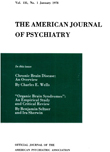THE CONDITIONED AVERSION TREATMENT IN CHRONIC ALCOHOLISM
Abstract
Since the introduction of the aversion treatment fifteen months ago at this hospital, 15 percent of an unselected group of patients have remained abstinent for a period of five to fifteen months. An abstinence rate of 55 percent, however, was obtained in a selected group of patients with a commendable sociological background. A period of at least three months sobriety was obtained in 52 percent of all patients treated. The aversion treatment is regarded not as a therapy in itself but merely as a valuable method to interrupt the alcoholic cycle for a conjectural period of time, which should be utilized for intensive psychotherapy.
Access content
To read the fulltext, please use one of the options below to sign in or purchase access.- Personal login
- Institutional Login
- Sign in via OpenAthens
- Register for access
-
Please login/register if you wish to pair your device and check access availability.
Not a subscriber?
PsychiatryOnline subscription options offer access to the DSM-5 library, books, journals, CME, and patient resources. This all-in-one virtual library provides psychiatrists and mental health professionals with key resources for diagnosis, treatment, research, and professional development.
Need more help? PsychiatryOnline Customer Service may be reached by emailing [email protected] or by calling 800-368-5777 (in the U.S.) or 703-907-7322 (outside the U.S.).



